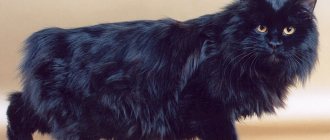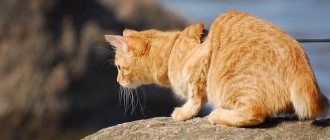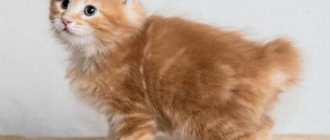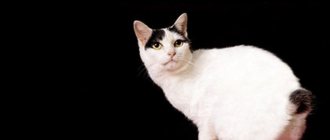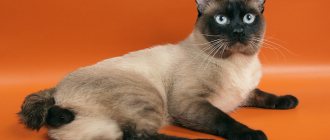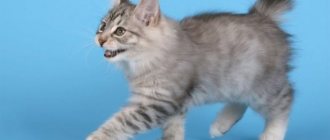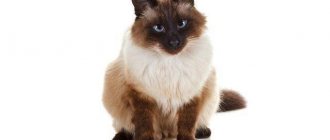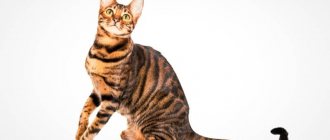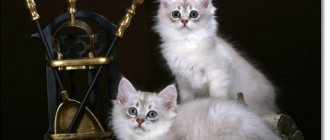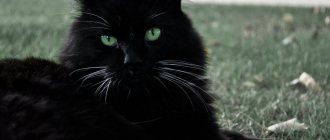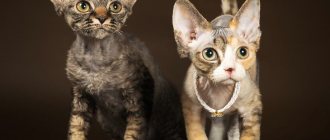Origin story
Among the ancestors of the Kuril Bobtail are the famous Japanese Bobtail: stately and strong cats with the same short tails and a “dancing” gait.
The Japanese kept these animals in temples and revered them as sacred objects, but the craving for a free life often took precedence over their usual comfort, and the cats ran away into the wild. Once on the Kuril Islands, Japanese bobtails began to change noticeably: the cats increased in size, their coat color changed, and their claws stopped retracting inward. And over time, when Russian settlers brought their favorites to the islands - wonderful fluffy Siberian cats - they became friends with them.
As a result of the mixing of blood, the modern Kurilian Bobtail was born - an outstandingly sized cat with thick dense hair and a funny pom-pom tail. Their amazing agility, unfailing hunting instinct and good health captivated people and in the late 80s, cat lovers started talking about them as a full-fledged breed. The first standard was adopted by the Soviet Felinological Federation in 1991, the general one (WCF) - in 1995.
Today it is not difficult to buy a Kurilian Bobtail kitten. There are quite a lot of nurseries operating in Russia, and there is no shortage of private breeders. The cost depends not only on the appearance, but also on the titles of the parents, the conditions of keeping and raising the animal. The price tag starts from 20,000 rubles. Taking an animal from your hands and without documents is fraught with problems in the future.
Buy a Kurilian Bobtail kitten
At the moment, nurseries of the Kuril breed are quite common in Russia and the CIS. The average price of a kitten from certified breeders is around 20,000 rubles
. The cost consists of many factors: keeping and raising a pet, the price of food, the titles of the parents, color and much more.
When you buy a baby from a nursery, you get a healthy animal with a pedigree, vaccinated and litter trained.
You should not trust all sorts of sellers without documents, you may get a pig in a poke.
What to name a Kurilian Bobtail
The nickname for a Kuril kitten is no less important than everything else. A pet, hearing its name, will always come running when called. You can name a girl or a boy based on the length of the tail, character, habits, personal preferences or color of the animal.
global $ads_google;
//data-ad-slot=”2475549904″ $ads_google = empty($ads_google) ? false : true; ?> if ($ads_google == false) {?> $ads_google = true; ?> } ?> Table of names of the Kurilian Bobtail
| Girl | Boy | ||
| Dina Fishka Zhanine Frosya Nara Nirvana Ayda Alka Marusya Kuzya Zhemchuzhina Burma Illyana Wendy Krona | Haze Bead Roxy Knopa Fury Pumpkin Redhead Bonya Trenka Rada Gracie Granta Kusya Tserceya Maha | Chelli Shurik Richard Push Ike Daniel Toshka Bundy Perseus Jabot Walter Mickey Grief Matisse Balt | Punch Indie Timka Ricky Shorty Bob Vader Mario Nils Jacques Spike Goodwin Karat Korzhik Zhorik |
Conclusions about the breed
There are people who sincerely do not see the point in having a pet. So, the Kurilian bobtail is one of the “useful” domestic animals. Who is a short-tailed cat suitable for?
- For those who need a real protector of order in the house. An animal of this breed will not only catch all the mice and rats, but also, in the event of a break-in, will repel the uninvited guest.
- For those who do not want to spend a lot of time and money on caring for a cat. These are healthy, clean and picky pets. In order to avoid the troubles of keeping a bobtail, it is better to buy a kitten from a nursery.
- For those who want to make a loyal friend who will get along with household members, children, and other furry family members. The Kuril cat is active, sociable, polite and moderately independent.
Many positive reviews from owners of the Kuril breed indicate that this breed is suitable for the role of the best among bobtails.
Kurilian bobtails are rightfully considered a national treasure of Russia.
Standards
| Standard | Description |
| Eyes | Rough, large and expressive. The iris can be any (snow-white cats have both blue and multi-colored eyes). |
| Head | Large, with smooth, rounded contours, wedge-shaped. The ears are small, with a wide base and rounded tips. They are slightly inclined forward and are equipped with tassels like those of a lynx. The whisker pads are plump and well expressed. The nose is of medium size, wide, level and straight. The chin is clearly defined, massive, with rounded edges. |
| Torso | The body is powerful, long, with developed muscles and strong bones. The hips are raised, the chest is wide. The limbs are not short, but they cannot be called long either. Powerful and strong. Paws are oval, large, spread out. |
| Tail | The tail is a distinctive feature of the Kurilian Bobtail. Outwardly it looks like a soft fluffy pompom. The length can be different: in cats with semi-long hair - 11-13 cm, with short hair - 1.5-8 cm. There is an undercoat, but it is quite small. |
| Wool | The coat can be semi-long or short. Bobtails with short hair have the same length all over their body. Cats with semi-long hair always have a fluffy collar, “pants” on the hind legs, socks and a plume on the tail. |
Felinologists distinguish 4 types of tails:
- Longest: includes 5-7 vertebrae. At first they form a straight line, and then twist into a loop. But such a tail is considered a serious drawback.
- Tail-broom: here there can be even more vertebrae - 8 or even 10. But the tail remains straight.
- Spiral tail: Also 5-10 vertebrae forming a small hook or spiral.
- The last and shortest tail is a stump. Consists of a minimum of 2 and a maximum of 8 vertebrae that are seriously deformed.
Profile
Required by the standard : The skull is flat, the profile with a slight smooth transition, without a pronounced stop. The nose is of medium length, straight. With a harmonious head structure, the length of the nose fits twice the length of the forehead. The chin is well developed, slightly rounded. Common disadvantages :
The nose is too short, disturbing the harmony of the head.
Convex forehead. Straight profile. The nose is not straight. Too pronounced transition from forehead to nose. Weak, narrow chin. Low forehead.
Weight table by month
The weight of an adult Kuril Bobtail reaches 4-7 kg, in cats - 5-9 kg.
| Age | Cat | Cat |
| 1 month | 280-400 gr | 330-460 gr |
| 2 | 550-750 gr | 880-1.2 kg |
| 3 | 1-1.2 kg | 1.1-2.2 kg |
| 4 | 1.3-2.4 kg | 1.8-3.2 |
| 5 | 1.7-2.7 kg | 2.6-3.6 |
| 6 | 2.6-3.4 kg | 3-4.4 kg |
| 8 | 3-4.1 kg | 4-5.2 kg |
| 10 | 3.2-4.4 kg | 4.4-5.8 kg |
| 1 year | 3.5-5 kg | 5-6.8 kg |
| 2 | 3.8-6 kg | 5.4-6.6 kg |
Colors
Colors are varied, but certain colors are prohibited in most show systems: fawn, lilac, chocolate, cinnamon, acromelanic (Tonky, Siamese and Burmese) and ticked colors.
The amber color was discovered only recently and has not yet been included in the general standard.
Acceptable colors:
- Tortoiseshell and solid (black, red, cream, blue, white);
- Tabby;
- Marble (red, black, blue, cream, tortoiseshell);
- Brindle (black, red, tortoiseshell, cream, blue);
- Spotted (red, black, blue, cream, tortoiseshell);
- Harlequin (including marble);
- Bicolor;
- Wang;
- With white spots.
In the photo there are cats of the Kuril Bobtail breed of popular colors: black, white, tortoiseshell
History of the breed
It is believed that Kuril Bobtails have lived on the Kuril Islands since the 8th century AD. However, they came to Russia quite recently - in the 90s of the last century. They were brought to the mainland by Russian research scientists, and breeders began breeding them. At the beginning of this century, an international federation and club of bobtail lovers appeared.
Now specialized nurseries exist in various countries of the world. The Kurilian Bobtail is a close relative of the Japanese Bobtail.
In conclusion, we will dispel some myths about Kurilian Bobtails.
Character and behavior
The Kurilian Bobtail is often compared to a dog, which is not surprising: in devotion to humans, this cat breed rivals all those you know. These cats are calm, affectionate and gentle creatures who, however, can quite stand up for themselves. People are adored and immediately upon arriving in a new home, they choose a leader, whom I will follow through thick and thin.
Your movements around the apartment will not go unnoticed: bobtails will follow you on your heels, trying to show you their devotion and readiness to help in business. Even if such obsession annoys you, you will have to come to terms with it: bobtails have curiosity and a desire to be in company until they are very old.
He gets along with other pets without problems, but this applies exclusively to dogs and cats. Small animals (birds, hamsters, rats, chinchillas) are potential prey for bobtails, which they will chase until they catch them.
Other family members are potential friends for the bobtail. Cats treat children very kindly, carefully and patiently. They will not allow themselves to let out their claws or bite a child, so do not worry about leaving your Kurilian Bobtail and your toddler alone.
What does this pose mean in cats: crouching to the ground, arching their back, starting a mournful song?
Mating gamesPreparing for a fight
Body Description
Required by the standard : Compact (close to square), muscular body with a slightly arched back and raised croup. The limbs are strong, of medium length, the hind legs are longer than the front, the paws are round. Common disadvantages :
Elongated body, small “dry” head.
Short hind legs (the same length as the front ones). Thin limbs with a normal body. Short limbs with a normal body. Strongly arched back (animal at rest).
The author of the drawings and text is Elvira Nagaeva, Kurikot nursery.
Back >
Care instructions
Wool
The Kurilian Bobtail's coat does not tangle and is not prone to tangles, so you should not brush them more than 1-2 times a week. These cats simply love to swim (by the way, Kurilian Bobtails are not only good hunters, but also excellent fishermen), so bathe them once every 1-2 months.
Claws
They get accustomed to the scratching post quickly and do not need additional nail trimming.
Eyes
But you need to watch your eyes and ears. Both are wiped with a damp cotton pad soaked in hydrogen peroxide, tea leaves or chlorhexidine.
Teeth
Teeth are brushed 2-4 times a week using a special toothbrush with soft bristles and cat toothpaste (Bars, Doctor ZOO).
In the photo there are cats of the Kuril Bobtail breed: short-haired and semi-long-haired
Character of the Kuril cat
Despite its origin and excellent hunting skills, the cat is distinguished by its rare complaisance and good-natured disposition. Bobtails are incredibly curious (so much so that they are sometimes considered a disadvantage), mobile and independent.
The cat feels great both in a city apartment and in a country house, where it keeps the entire mouse population at bay. Therefore, it is not worth keeping it together with smaller animals - the hunting instinct will almost certainly work. But she quite gets along with dogs, moreover, she borrows some dog habits:
- Bobtails are incredibly loyal to one owner, whom they choose themselves. In his absence they can be very sad.
- Unlike other cats, they are not afraid of water. Of course, they don’t like to splash and swim, but they endure the necessary bathing procedures with steadfastness.
- They are incredibly talkative; in addition to meowing, they also make other sounds uncharacteristic of cats, up to and including a low growl.
- They are perfectly trainable, able to remember several commands and even (which is almost incredible for cats) carry them out according to their mood. Some breeders managed to teach Kurilians to fetch a ball.
- They don’t know how to retract their claws, so they click loudly when walking.
Catering
High-quality food for the Kuril Bobtail is the key to a long and healthy life. So remember:
- An adult animal is fed 2 times a day: in the mornings and evenings. You should wash the bowls once a day (do not use any detergents other than laundry soap) and pour clean water at a comfortable temperature into the drinking bowl every day. Kittens 2-5 months old are fed 3-6 times.
- Don't feed your cat from your table. Fatty soups, fried potatoes, chocolate and other favorite foods, unfortunately, are real poison for the animal. Sweet, salty, smoked, sour, canned, flour and baked goods are strictly prohibited.
Natural products
Important diet foods:
- Meat (beef, chicken, turkey, rabbit).
- Fish (both river and sea).
- Plant foods (zucchini, pumpkin, carrots, green salad, asparagus, broccoli, parsley, dill, beans).
- Chicken yolk (boiled), quail eggs.
- Porridge (rice, oatmeal, buckwheat, millet).
- By-products (liver, kidneys, ventricles, hearts).
- Dairy products cause metabolic disruption. The same applies to potatoes, baked goods, dog food, and human canned food. But sprouted oat grains for bobtails are one of their favorite treats.
The water should either be passed through a kitchen filter or left for a day in an open container.
Recommended food
When choosing dry food, buy only food from the holistic group. Applaws, Farmina N&D, Jaguar. Other foods are not suitable for Kurilian Bobtails.
Below are the recommended holistic class foods. Links with the names of the food are clickable, on them you can, within our website, get acquainted with the descriptions of the food and read reviews from owners of Kuril Bobtail cats.
| Holistic | Holistic | Super premium |
| Acana | Go Natural | Organix |
Diseases
The immunity of cats of this breed is enviable. But they also have weaknesses.
The first thing you should pay attention to is the ponytail, or more precisely, the area under it. At the very first inspection, find out whether there are any cracks, irritation or ulcers. Such a short length is a prerequisite for the occurrence of an inflammatory process or prolapse of the anus. The Kurilian Bobtail should be examined regularly, and if damage is found, take it to a veterinarian for examination. Remember: if you feed your cat poorly, he will develop this kind of illness quickly.
Ordinary sea buckthorn oil helps to deal with small cracks: they lubricate the anus area with it and make sure that the cat does not lick it right away.
The second nuance: in Kuril Bobtails, the urine pH is significantly different from the urine of cats of other breeds (7-7.5 versus the usual 6-6.5). Therefore, they rarely suffer from urolithiasis of the alkaline type.
Timely and regular vaccination will help protect your pet from a number of diseases - rabies, rhinotracheitis, panleukopenia, calicivirus, leukemia, peritonitis. The kitten receives its first vaccinations at the nursery, but in the future you will have to learn the vaccination calendar and take your pet to the doctor yourself.
Information about the procedures is entered into the veterinary passport. You should not vaccinate yourself (if you do not have the appropriate education: a mistake can lead to serious consequences. Do not try to vaccinate your pet against all diseases at once: this is too much stress on the immune system!
Health of Kuril bob-tailed cats
Since the breed is semi-wild, Russian Bobtails are extremely rarely exposed to diseases. Excellent health helps cats live a long, rich life, whose duration is 15–20 years.
Nature has rewarded Kurilian Bobtails with good health
To maintain immunity and protect against diseases, Kuril cats need to be wormed regularly (at least once every six months) and given mandatory vaccinations.
Vaccination is carried out as follows:
- The first vaccination for a kitten should be done at the age of 8–12 weeks;
- then revaccination is carried out after 3 weeks;
- after which the cat is vaccinated every year at the same time in order to prevent diseases.
It is important to remember that vaccination cannot be carried out when the animal is not healthy or the kitten’s teeth are changing. And two weeks before visiting the veterinarian, your pet needs to be rid of helminths and parasites on the fur (fleas and ticks).
The main vaccines for Kurilian bobtails remain the same ones used for other cats - against rabies, panleukopenia (distemper), respiratory diseases, as well as against leukemia and infectious peritonitis.
Despite the measures taken, representatives of the breed in adulthood can sadden owners with the appearance of certain ailments - inflammation of the mucous membranes of the eyes, problems with urination. And kittens often have difficulty defecating. These are associated with the specific structure of the tail of the Kurilian. Therefore, if the baby behaves restlessly near the tray, you need to examine the pet and remove excess feces from under the tail.
At the same time, the bobtail gene does not in any way affect the health of the furry animal.
Video: vaccination of the Kurilian Bobtail
Advantages and disadvantages
- They are not afraid of water.
- Good hunters.
- They don't mark their territory.
- They know how to warn about dangers.
- They learn quickly.
- Friendly.
- Devotees.
- They have good health.
- They love to talk.
- They can be intrusive.
- Loneliness is difficult to bear.
- They do not like to sit on their laps or hands.
- Bobtails often have problems with the toilet and anus.
- Demanding something, they howl unpleasantly and frighteningly.
